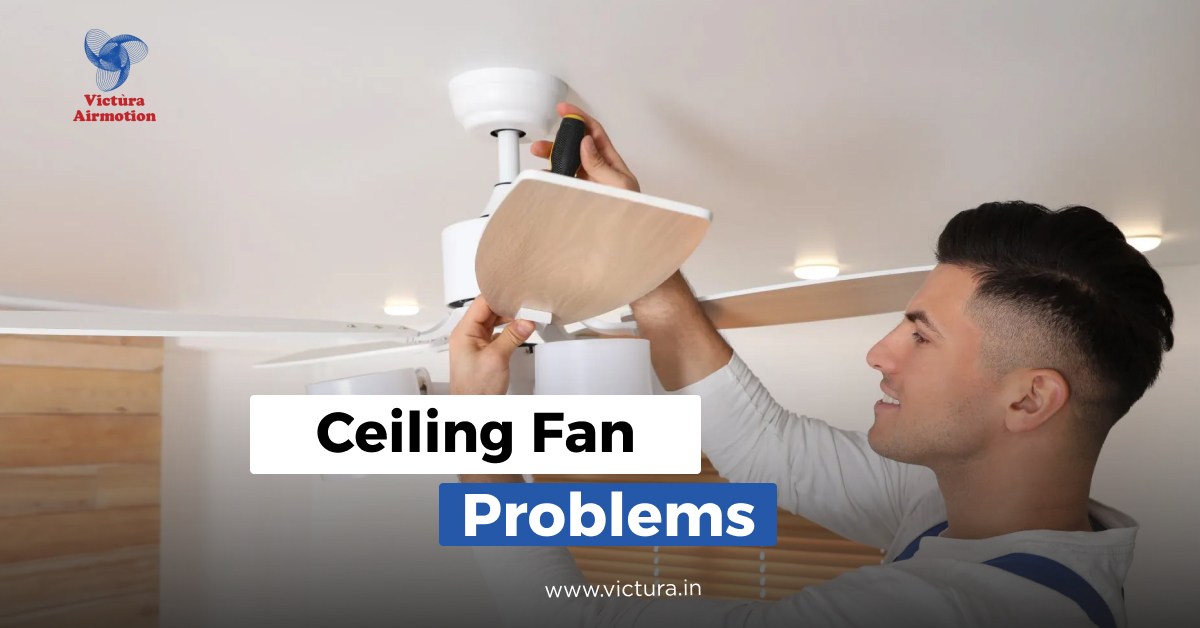Ceiling Fan Problems happen; it’s not a big deal. You may have been through this already: you’re lying on the couch, scrolling through your phone, and suddenly you hear a clicking sound. No, it’s not the neighbours; it’s your own fan! Or worse, it just stops spinning?
The truth is, we don’t really notice our ceiling fans until something goes wrong. The good news? Most fan issues are surprisingly common and totally fixable once you know what you’re looking at. So whether your fan’s making strange noises or feels more like a lazy breeze than a gust of air, this blog has your back.
Let’s break down the 7 most common ceiling fan problems and how to fix them, plus some tips to keep your fan spinning strong for years to come.
Top 7 Common Ceiling Fan Problems and Solutions
Even the best quality ceiling fans have them, so you should know what you’ll be dealing with:
1. Capacitor Issues: Burnt-Out From All The Heat
You turn on the fan. Nothing happens. Or it only runs at one speed, slowly. You call in the technician and find out it was just the capacitor that burned out. Easily replaced with a new one for just ₹150.
What’s going on:
The capacitor (that little component responsible for jumpstarting the motor) might’ve burnt out. It’s like trying to start your scooter with a dead battery.
The fix:
Call in an electrician to replace the capacitor. It’s usually a 10-minute job if you’ve got the right part.
2. Wobbly Fan: A Dancing Disaster
You get home after a long day and just want to chill for a bit. But as soon as you turn on the fan, it begins to shake like it’s tipsy. This kind of thing can make you sigh in frustration.
What’s going on:
Unbalanced blades or loose screws. Sometimes, too much dust gets collected, leaving the fan uneven. Hope you didn’t throw out those little packets of plastic clips that come with fans, it’s going to be handy.
This happens when dust piles up unevenly or the fan is not put up correctly.
The fix:
Turn off the fan, tighten the screws, and wipe the blades. Use a blade-balancing kit or keep switching the blades until they are stable.
3. Still Water: The Fan Not Spinning
You hit the switch. Nothing. Not even a hum. You look up, and it’s stuck, just staring back at you like it’s doing the mannequin challenge trend from 2016. The secret is the motor; keeping it clean and sealed is the key.
What’s going on:
Loose wiring? Burnt capacitor? Jammed motor? It could be any of these.
The fix:
Start with the basics: check your switch and MCB. Still dead? Get an electrician to inspect the internal wiring or the motor housing.
4. Noisy Operation: The Soundtrack You Didn’t Ask For
A low hum in the day is a loud one at night because of the silence. The sound can break one’s sanity. You can’t sleep, and your fan’s now the star of a horror movie soundtrack.
What’s going on:
Loose screws, poor installation, dried bearings, or internal motor hum, take your pick.
The fix:
Tighten everything in sight. Then add a drop of oil to the bearings. If it’s still humming, there could be an internal issue that needs a pro.
5. Damaged Fan Blades: Like A Broken Wing
One blade looks wonky. Or you hear an uneven thudding sound as the fan spins. If you live near the coast or in a humid climate, your fans are more prone to this kind of damage.
What’s going on:
Blade(s) might be bent, cracked, or warped — especially common in older wooden or MDF blades.
The fix:
Replace the damaged blade — but only with a matching one. Mismatched blades = wobbles and motor strain. Little pro tip for you: invest in ABS plastic fans.

6. Low Speed: The Slowpoke
Fan’s on full speed, but it feels like a gentle whisper of air. You’re sweating, wondering what’s gone wrong.
What’s going on:
Again, that tiny capacitor might be at fault. Or the motor’s just tired from years of use.
The fix:
Swap the capacitor. If that doesn’t help, time to check the motor or… consider a new fan. If your fan is more than 8–10 years old, replacing it might be more energy-efficient in the long run.
7. Bearing Issues: The Groan of Friction
The fan sounds like it’s grinding metal. You’re waiting for sparks. Not fun. Even modern ceiling fans can have this issue.
What’s going on:
The motor bearings have dried out or worn down. Bearings help the motor spin smoothly — when they fail, it’s friction city.
The fix:
If it’s just dry, lubrication can help. If it’s damaged, a technician can replace the bearings. Don’t ignore this — the longer you wait, the worse it gets.
Extra Breezy Tips: How to Keep Your Fan Healthy
- Dust regularly: Even a little dust can unbalance blades and slow performance.
- Look at screws each month: Make them tight so they won’t cause big problems.
- Put on a stabilizer: It keeps voltage changes from damaging the motor or capacitor.
- Turn off if not in use: Helps it last longer and cuts power use.
- Lubricate bearings once or twice a year: Especially in older fans.
Planning to Buy a New Fan? Here’s What to Keep in Mind
Choosing a new ceiling fan? Here’s what kind of smart fans to look for:
- Energy-efficient motor (BLDC): Saves electricity and money.
- High air delivery: Check the CMM or RPM — more is better.
- Silent operation: Especially for bedrooms.
- Remote control or smart features: Because who wants to get up?
- Make blades rust-free: This is key for rooms like kitchens or bathrooms.
- Ensure good warranty and service: Value the support you get after buying.
Conclusion
Ceiling Fan Problems can wreak havoc on your home if you don’t keep them in check. It’s fine if your ceiling fan acts up after long usage; every machine needs a little bit of care here and there.
Whether it’s your fan’s capacitor that’s burnt or the bearings have come loose, most of these common problems also have quick solutions. Just a phone call to an electrician will solve most of these issues.
Now, you know how to keep your fan in good shape, how it runs, and the issues it can have. Next time any issue pops up, you’ll know how to fix it fast.
Frequently Asked Questions
Q1. What is the common ceiling fan problem?
A burnt-out capacitor is the biggest problem. It can slow down the fan or stop the fan completely. Wobbling and uneven blades are also common problems.
Q2. What is the common problem of an electric fan?
Electric fans can have weak airflow, be loud, or not turn on. These issues are often due to motor troubles, dust, or a bad capacitor.
Q3. How do I know if my ceiling fan capacitor is bad?
If your fan is slow, doesn’t spin, or sticks to one speed, it might be a bad capacitor. You might hear a low humming sound but see no blade movement.
Q4. Why is my ceiling fan not cooling my room?
Ceiling fans stir the air to make you feel cool, but don’t drop the room’s heat. Not cooling well can be from low speed, poor airflow (low RPM), or bad fan placement.
Q5. Why is my ceiling fan weak?
A weak fan may be due to a bad capacitor, dust in the motor, or old parts. It could also be too weak for the room size or set too low due to switch problems.
Q6. Why is my ceiling fan speed fluctuating?
Speed changes can come from uneven power, a dying capacitor, or loose wires. Less often, the speed control switch might be broken.
